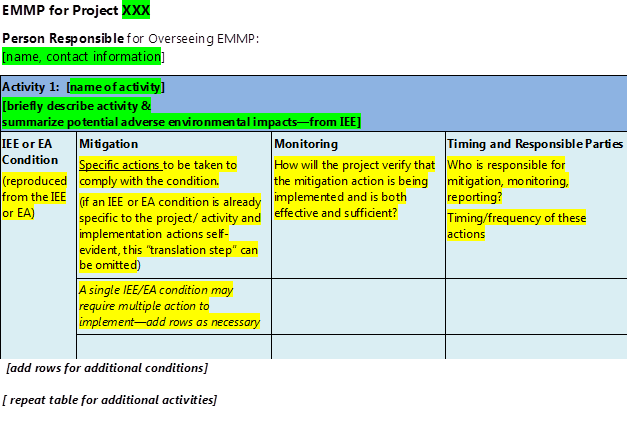Mitigation, Monitoring and Reporting are the essential elements of environmental compliance during implementation of USAID-funded activities.
Mitigation is the implementation of measures designed to eliminate, reduce or offset the undesirable effects of a proposed action on the environment. Most USAID Initial Environmental Examinations (IEEs) and all Environmental Assessments (EAs) establish conditions (mitigation requirements) that must be complied with during activity design and implementation.
Monitoring is the essential complement of mitigation. It is BOTH (1) determining whether mitigation is being implemented as required; and (2) determining whether mitigation is sufficient and effective.
EMMPs. Experience shows that systematic implementation of mitigation measures – and thus compliance with IEE and EA requirements – requires an Environmental Mitigation and Monitoring Plan (EMMP). For this reason, EMMPs are required by most newer IEEs and EAs across most USAID bureaus. EMMPs are also called Environmental Management Plans (EMPs), Mitigation and Monitoring Plans (M&M Plans), and by other, similar names.
Put simply, an EMMP :
- TRANSLATES IEE or EA conditions into specific mitigation measures (if the conditions are general)
- SETS OUT indicators/criteria for monitoring the implementation and effectiveness of mitigation measures
- ESTABLISHES timing and responsible parties
An EMMP may also include budgeting information (costing of mitigation and monitoring measures) and a log for recording monitoring results. EMMPs are usually in table form. Formats are usually flexible; sometimes specific formats are required by the IEE or EA.
Here is a typical format:
Reporting. The ADS requires that USAID AORs and CORs actively monitor the compliance of projects and activities under their purview with the environmentally protective requirements set out in IEEs and EAs conditions. For AORs or CORs to fulfill these responsibilities, implementing partners must report on environmental compliance as one portion of routine project performance reporting.
Mitigation, Monitoring, EMMP & Reporting Resources: The following resources provide additional information on each of these topics
- Overview of Mitigation key concepts and principles: GEMS training Presentation: Baseline Characterization, Impact Identification and Mitigation Design PDF 1MB
- Overview of Monitoring and EMMPs: GEMS training Presentation: Monitoring and EMMPs PDF 2MB
- More on mitigation and monitoring theory: Topic Briefing: Intro to EIA [bring in from ENCAP site:
- Topic Briefing PDF (860 KB)
- Topic Briefing Word (4 MB)
- Sector-specific mitigation and monitoring guidance: consult the sectoral environmental guidelines.
- Overview of Environmental Compliance Reporting: GEMS training Presentation: Environmental Compliance Reporting PDF 445KB
- How-to EMMP guidance: EMMP Factsheet (Focused on Africa Bureau formats and expectations, but generally applicable.) PDF 227KB
- Basic EMMP Template Word (31 KB)
- Environmental Budgeting Toolkit
